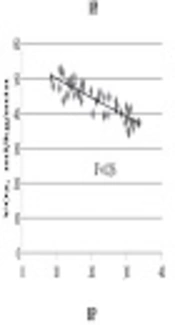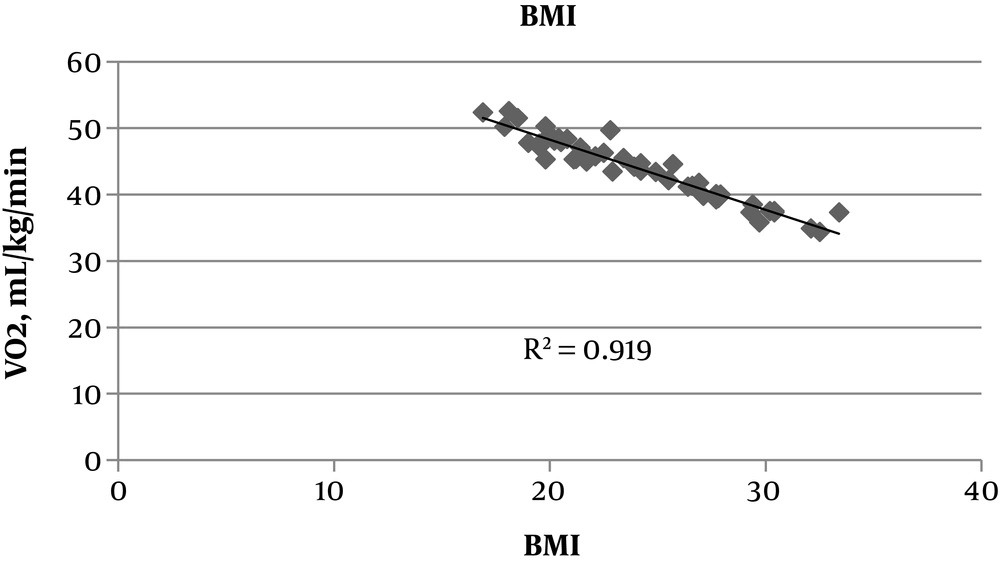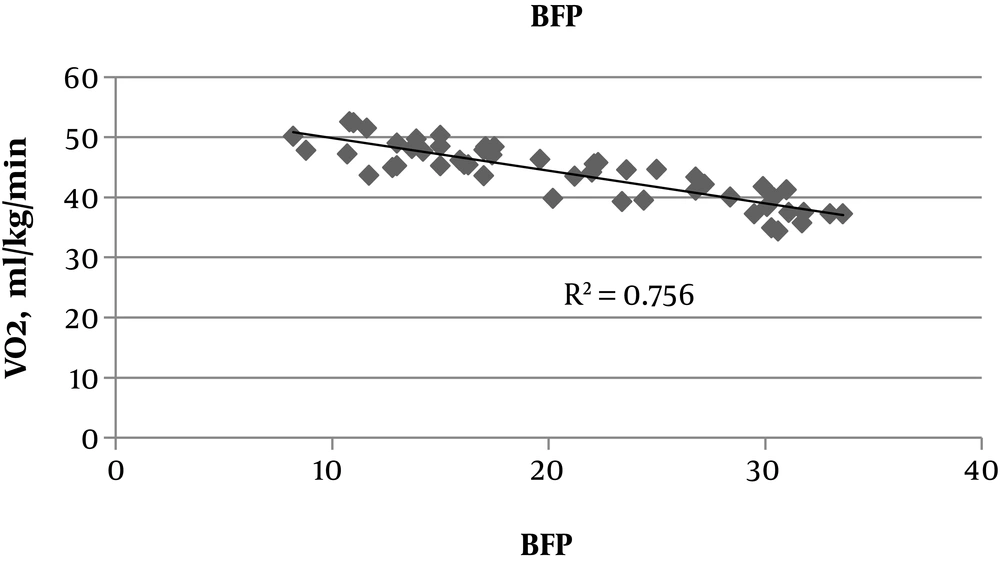1. Background
One of the most important applications of ergonomic science is adapt the work type with human capabilities and limitations (1). Hence, to measure physical activity, capacity is one of the important topics of ergonomic science, which has been emphasized by the International Labor Organization (2). One of the effective measures in this regard is to measure the physical work capacity (3). The physical work capacity (PWC) is the maximum level of energy, which an individual can use in an 8-hour period in kcal/min without experiencing any physiological stress and physical fatigue (4). Nowadays, scientists state that the maximal oxygen consumption (VO2max) should be used to determine the physical work capacity (2). The maximal aerobic capacity reflects the maximal oxygen transfer rate of the muscles, which is acceptable in many cases to measure the fitness between the individual and the considered work (5). Maximal oxygen consumption is considered as a first-class standard to measure the practical limit of the cardiorespiratory system (6, 7). The main unit for maximal aerobic capacity measurement is expressed in l/min or mL/min. However, as the absolute value of this variable is strongly affected by body weight, it is often expressed with unit of mL/kg/min (8). Various factors affect the maximal aerobic capacity, including environmental, psychological, physical, and physiological characteristics of individuals (9). With increasing the aerobic power, that is, oxygen uptake capacity, the physical power will be higher. It means that an individual can perform heavy activities better and more easily. Thus, aerobic power is an appropriate criterion to express the physical ability of individuals to perform work or an individual fitness with the work (10). Physical fitness includes five elements of aerobic capacity, muscle strength, muscle endurance, flexibility, and body composition (11). Research has indicated that the physical composition of individuals as another physical factor is closely associated with aerobic fitness. The studies conducted in this regard indicate that the maximal aerobic capacity is associated with body composition factors such as body fat percentage, body mass index, and body muscle mass (12, 13). Researchers have also presented valid estimates of aerobic fitness using the variables of age, gender, body fat percentage, and body mass index (BMI) (14, 15). Results of previous studies suggest that low physical activity results in a low level of physical fitness and, as a result, high body fat percentage (16). The maximal aerobic capacity will be measured based on the precision required and the existing level of risk by using various methods, including direct and indirect methods (17). In the indirect method, laboratory tests based on heartbeat response are used (18). Direct measurement of VO2max requires specialized equipment and considerable physical effort and motivation. Moreover, when high precision is required, direct tests are used to determine the maximal oxygen consumption (17). Cycle ergonomic, conveyor belt, and stair test are the tools used to measure the maximal aerobic capacity of individuals (19). In addition, Treadmill Bruce test is used as a standard method to measure the aerobic capacity and cardiovascular fitness of athletes or healthy non-athlete individuals (20).
2. Objectives
Very limited studies have been conducted so far in Iran to evaluate the effect and the relationship between body fat percentage and body mass index on work capacity of individuals. Most of the studies conducted in this regard used indirect methods, which have lower precision in the estimation of physical activity capacity. Hence, the present research was carried out to estimate the capacity of physical activity and evaluate the correlation between body fat percentage and body mass index using direct reading methods. Given the high accuracy and precision of the measured parameters, the present research can be used as appropriate in the assessment perform activity capacity.
3. Methods
This is a cross-sectional study conducted on 50 male volunteer students of Ahvaz University of Medical Sciences with an age range of 20 - 30 years to examine the factors affecting the work capacity of the subjects. Necessary explanations were provided on the method of implementing the work and the consent of participants was taken to complete the form of demographic information questionnaire. After completing the questionnaire the subjects were prepared to perform the work capacity test by considering the inclusion criteria, including lack of history of cardiovascular, respiratory, musculoskeletal disease, and lack of history of drug use. Participants with history of exercise were excluded from the study. The test to determine the physical work capacity was performed using the Bruce protocol on h/p/cosmos company treadmill (Saturn model, Germany), gas analyzer (ergospirometry) (Gunshorn model, Germany). Bruce Treadmill test includes seven 3-minute steps (21). The form and speed of the treadmill are automatically changed owing to an increase in slope at each step (20). In the first step, an individual starts walking at a speed of 2.7 km/h and a slope of 10%. In the second step, the speed increases to 4 km/h and the slope increases to 12%. The speed and slope, respectively, increased to 5.5 km/h and 14%, 6.8 km/h and 16%, 8 km/h and 18%, 8.9 km/h and 20%, and 9 km/h and 22% in the following steps (20, 21). The body fat percentage and body mass index were measured, while the participants had on light clothing, by using a machine method. The height of the subjects was measured, without any shoes on, by using a tape meter with a precision of 0.1 cm. Moreover, the components of the body composition of the subjects including weight, body mass index, and body fat percentage were measured by using the direct reading method and Body Composition Device (Olympia3.3 model, Korea) during performing the Treadmill Bruce. The data were analyzed using the SPSS 21 software after performing the necessary measurements. In this study the variables were continuous and the distribution of data was normal (one-sample Kolmogorov-Smirnov test), hence the Pearson correlation coefficient was used to test the hypothesis to determine the relation between BMI, BFP, and VO2max of the research participants.
4. Results
A total of 50 Ahvaz University of Medical Sciences students, with the age range of 20 - 30 years, participated voluntarily in this research. The mean age of the participants was 21.36 ± 2.08 years. The mean and standard deviation of the height of the subjects were also 176.16 ± 6.02 cm. The mean of maximal aerobic capacity of the subjects in this research was estimated 44.01 ± 4.75 (mL/kg/min) using a Bruce Treadmill test. Table 1 illustrates the mean and standard deviation of the components of the body composition studied.
| Body Composition Parameters | Mean ± SD |
|---|---|
| Weight, kg | 74.78 ± 15.01 |
| Body mass index, kg/m2 | 24.03 ± 4.31 |
| Body Fat, % | 20.77 ± 7.6 |
Descriptive Data for Body Composition Parameters
Table 2 illustrates the correlation between body fat percentage, body mass index, and physical work capacity of the subjects. The results suggest a significant and reverse correlation between the variables of body composition and VO2max the physical work capacity of the subjects (P ≤ 0.05).
| Variable | P Value | R Value |
|---|---|---|
| Body fat, % | 0.00 | - 0.87 |
| Body mass index, kg/m2 | 0.00 | - 0.959 |
Correlation Between BFP and BMI with VO2max
In addition, the results of simple linear regression analysis suggest a significant and linear relationship between BMI and VO2max (R2 = 0.919, P ≤ 0.001). This correlation suggests that the physical work capacity of individuals decreases with increasing the body mass index (Figure 1).
In addition, with regard to the relationship between two variables of body fat percentage and VO2max, simple linear regression analysis results show a significant and negative linear relationship between these two variables (P ≤ 0.001, R2 = 0.756). This relationship indicates reduction in the work capacity of individuals as a result of an increase in BFP (Figure 2).
5. Discussion
The objective of this research was to evaluate the relationship between body fat percentage, body mass index, and physical work capacity. In this research, the mean age of participants was 21.36 ± 2.08 years. According to the results of this research, there was no significant relationship between mean VO2max and age. This result was consistent with that of studies conducted by Mombeini et al. (9) and Habibi et al. (22). However, it was inconsistent with result of the study conducted by Chatterjee et al. (23) and Daneshmandi et al. (24). In justifying lack of a significant relationship between age and work capacity, we can refer to the limited age range and the younger age of all participants of the research.
The mean and standard deviation of VO2max in the subjects was estimated as 44.01 ± 4.75 in terms of mL/kg/min. This value was close to the results of the research conducted by Mondal and Mishra (17) in males (43.25 ± 7.25 mL/kg/min) and Sterkowicz et al. (41.9 ± 4.62 mL/kg/min) (25). In addition, the results of this research were high than those reported in the research conducted by Hosseinabadi et al. (36.9 ± 3.72 mL/kg/min), Daneshmandi et al. (35.95 ± 7.39 mL/kg/min) and Rafieepour et al. (32.60 ± 10.39 mL/kg/min) (10, 24, 26). The mean age of the participants was 40 years in the research conducted by Hosseinabadi et al. (10) and 32.01 years in the research conducted by Daneshmandi et al. (24). As the participants in the research are at a young age, with the mean age being 21.36 years, the inconsistency can be attributed to the difference in work capacity in different age groups and the limited age range of the subjects (young students). In addition, in the research conducted by Rafieepour, 58.1% of the participants were female (26). As this research was conducted on males, and gender is a factor affecting the physical work capacity, the difference in results might be due to the effect of gender on the individuals' work capacity. In this research, the mean BMI and BFP was determined (24.03 ± 4.31) kg/m2 and (20.77 ± 7.6)%, respectively. Based on the World Health Organization (WHO), the BMI of the subjects was within the normal range of (18.5 - 25) kg/m2 (19). In this regard, the relationship between body mass index and maximal work capacity in this study showed a significant relationship between these variables. These results showed that the value of VO2max, in terms of mL/kg/min, decreased with an increase in BMI. It is in line with result of previous studies (27-29). The results of studies conducted by Mondal and Mishra (17), Sterkowicz et al. (25), Hsieh et al. (30), and Laxmi et al. (31) were consistent with the results of this research. With regard to the reverse relationship between body mass index and VO2max, several studies have referred to the effect of weight and body composition on VO2max, which might be due to the physiological effects of weight gain. Weight gain and BMI increases the body’s need for blood supply to the tissues, and owing to limited heart's capacity, blood is not supplied well to tissues, therefore, the oxygen available to the tissues is reduced (32). In this research, the mean and standard deviation of the BFP in the studied students were estimated to be 20.77 ± 7.6%, which was within the normal range (16% - 24%) (17). According to the results of this research, a significant and negative relationship was found between work capacity of individuals and body fat percentage (% PBF), which is consistent with the results of research conducted by Amani et al. (20), Minasian et al. (33), and Ostojic et al. (34). In addition, in a research conducted by Shete et al. (8) and Pribis et al. (35), there was a negative relationship between VO2max and BFP. Increased fat around the heart, which occurs usually due to obesity, can reduce the heart pumping. Thus, it might finally reduce the heart capacity and the ability of performing the daily tasks (20, 32).
The results of this research showed a significant and negative correlation between body mass index and body fat percentage as well as capacity for performing the physical works. These results showed that BMI and BFP variables are among the factors affecting the capacity of individuals to perform their physical works. This study is one of the first studies conducted to estimate the association between body fat percentage, body mass index, and VO2max using direct reading method. The results of this research showed that the limitations of previous studies, which used the indirect methods with lower precision to estimate the capacity performing physical works, can be resolved by estimating these variables using direct reading methods. Some of the limitations of this research included the cross-sectional nature of the research and the lack of observing the effect of different factors over time, the limited population, and the lack of evaluating the effect of gender on work capacity. Hence, it is recommended that similar studies be conducted with larger sample size and on workers.
5.1. Conclusions
One of the important factors in job ergonomics is determining the capacity of performing the physical work. The results of this research suggest the effect of body fat percentage and body mass index on the capacity of performing the works; which might be effective in selecting the appropriate people based on type of activity and the capability of people finding various jobs. As the measurement of these variables using indirect methods has a lower precision, it is recommended that direct reading methods be used to estimate the work capacity and the correlation between these variables and the capacity of performing the work.


